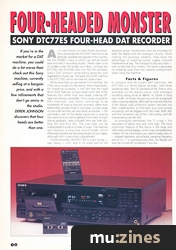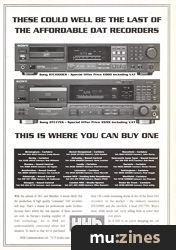Magazine Archive
Home -> Magazines -> Issues -> Articles in this issue -> View
Four-Headed Monster | |
Sony DTC77ES Four-Head DAT RecorderArticle from Recording Musician, February 1993 | |
Four heads can be better than one — and they needn't tax your overdraft, as Derek Johnson discovers with Sony's latest DAT recorder.
If you're in the market for a DAT machine, you could do a lot worse than check out this Sony machine, currently selling at a bargain price, and with a few refinements that don't go amiss in the studio. Derek Johnson discovers that four heads are better than one.

As is well known to most home recordists, Sony produced the first DAT machine to be generally available and popular in this country, the DTC1000ES, many of which can still be found alive and well in recording studios. There's been a lot of models under the bridge since then, not least the DTC750, the DTC55ES and the TDC D3 portable, Sony's DAT product range being generally well regarded for studio use. The latest Sony DAT machine is the DTC77ES, which we have for review here.
While essentially an up-market hi-fi machine, the 77ES has a couple of nifty extras. Most importantly, for mastering purposes, is the fact that the head drum (DAT features a rotary head much like VCRs) features four rather than two heads, making off-tape monitoring a possibility. This is quite unusual for DAT machines, and allows recordings to be monitored off tape as they are recorded, rather than before they actually make it onto tape. A wide range of sub-code facilities are also easily accessible — the sub-code is part of the digital signal and is used by the machine as an aid to getting from track to track during playback; data included here are Start IDs, Skip IDs and End IDs. The sub-code can be manipulated in quite a number of ways. The machine also features a long play record mode, which effectively doubles the recording length of your tapes, although with a restriction in bandwidth.
Constructionally, the DTC77ES is a very sturdy — nay, heavy — unit, due in no small part to the separate power transformers that are provided for both the digital and the analogue circuitry. While making the package weighty, they have the advantage of keeping power supply induced interference at bay. The transport is also very solid — with no less than four motors. The result is absolutely no irritating noise from the cassette compartment when using the machine.
Facts & Figures
In common with all current DAT machines, the DTC77ES is a 16-bit digital recorder, with three sampling rates. The CD standard of 44.1 kHz is only available via the digital inputs, with analogue recording being done at 48kHz, or 32kHz in long play mode. All three frequencies will be recognised when copying digitally, although be warned that the SCMS digital copy protection system (see box) has been implemented, so that even your own private recordings will be tagged with the code. Both A/D and D/A convertors are of the 1-bit variety, with 8X oversampling on the D/A.
As previously mentioned, the 77 is big — the equivalent of about two rack units high. The most prominent feature of the fascia is the large and informative central display, which is very comprehensive indeed. All the information you need to keep track of — elapsed tape time, record levels, sampling frequency and so on — is unambiguously clear; the display can even be turned off completely if you like.
Brief Specification
| Frequency Response: | 2Hz-20kHz, 2Hz-14.5kHz long play |
| Signal to Noise Ratio: | More than 93dB |
| Dynamic Range: | More than 93dB |
| Line Input Impedance: | 47kohms |
| Line Output impedance: | 470 ohms |
Slightly more confusing, for the newcomer especially, is the vast array of switches. Some will be very familiar to owners of cassette decks (transport controls) and CD players, but others may be baffling. Most of these are to do with sub-code functions — the writing and erasing of start, skip and end IDs. These are well explained in the manual, but basically, Start IDs (and their program numbers) allow you to have the machine search through a tape and start at the track you require. For example, if you're playing track one, and want to hear track five next, press the AMS (or track search) button four times, and the 77 automatically fast forwards to that track and starts playing. The same goes for finding tracks before the one being played. The Skip function can be set to always skip over a track (perhaps a bad take) every time the tape is played; a Skip ID can be removed at any time.
A numeric key pad is used to select tracks (or alter the clock or date), and other buttons select between standard and long play modes and digital or analogue inputs. A 'Fader' button allows a fade in or out to be applied while recording or playing back. This can be set to between 0.2 and 15 seconds, making it very useful when your hands are full during a mix — one button press, and you have an instant, perfectly balanced fade.
Most DAT machines fall into two categories: those with a drawer to take the tape, and those which offer a top-loading trap door. The DTC77ES has neither; rather, it follows the format of the more downmarket DTC750 and uses a rather interesting compartment that folds out of the front. This being a Sony product, I probably haven't too much cause for worry, but I can't help feeling that the more moving parts there are, the more things there are to go wrong. On the up side, however, a cassette placed in the 77's compartment is quite visible, visibility which is further enhanced through an internal light, but slightly let down by a small 'window'.
Rear panel connections are simple: analogue stereo inputs and outputs are on phono sockets, and digital inputs and outputs are available on both coaxial and optical connectors; phono leads (for analogue connections) and a coaxial lead (for digital connection) are provided. Also part of the package are a comprehensive remote, which duplicates all major front panel functions, and a 185-page manual. Don't worry: it's a multilingual, European affair with just the first quarter in English (French, Italian and Spanish instructions take up the other quarters).
Studio Use
In use, the DTC77ES performs quite as expected. In a studio environment, the quiet transport comes as something of a relief after some of the popular portable models that do tend to buzz a bit, and the much-lauded four-head facility, well, works. It is just like having a third head on a three-head cassette deck, and means that recordings can be checked on the fly, with faults being noticed well before playback. The only difference is that there isn't quite as big an audible gap when you switch between your source and the off-tape signal — the actual gap is almost inaudible. Another useful feature is that record levels can be set without the machine necessarily being in record ready mode, since unless a tape is engaged, any signal present at the record in sockets is passed through to the headphones. It is also worth mentioning that the headphone socket provides a lot of level — the pain threshold can easily be reached with the right pair of headphones.
To check out cross-machine compatibility, I tried the DTC77ES with tapes recorded in various other DAT machines, including other Sony models, and machines by Aiwa, Panasonic and Casio. All played without incident.
The inclusion of the Serial Copy Management System on the 77ES is as unwelcome as it always is, although it's perhaps not surprising on what is after all a consumer machine — note that several proprietary boxes are available that strip the code from the digital stream. Worth noting is that the majority of DAT machines are actually consumer models with warranties that are invalidated if used in a non-domestic situation (ie commercial recording studios).
In Conclusion
Sony DTC77ES
- Four heads and four motors for off-tape monitoring and stable transport.
- Familiar, high quality Sony performance
CONS
- Ubiquitous SCMS digital copy inhibit.
- Bulky size.
- Doesn't record at 44.1kHz via the analogue inputs.
PERFORMANCE 8/10
VALUE FOR MONEY 8/10
Sony's latest machine sounds good. The input circuitry is forgiving — although digital systems do not appreciate over-hot signals — and the sound off-tape is crisp and accurate without sounding cold or clinical. The machine as a whole is straightforward in operation, with the sturdy build inspiring confidence, and the four-head system setting it apart somewhat from the usual run of budget DAT. Having said that, until recently this machine retailed at around the £1000 mark, distancing it somewhat from the budget category. However, that price has just fallen significantly: at £699, the DTC77ES becomes pretty good value, especially since it appears that the time has come when very cheap DAT recorders may cease to be so widely available. As pointed out recently by Gary Dent of Music Labs, DAT as a consumer music format has been an unmitigated failure, for whatever reasons, and the many manufacturers who had geared up to mass production of cheap hardware (such as the tiny portables we've seen so many of) are realising that DAT has little mass potential. With the advent of new consumer formats, such as DCC and Minidisk, manufacturers have pulled out of large-scale DAT production, meaning that DAT machines may no longer be subject to economies of scale, and, as studio-only mastering, may well be made in smaller numbers and at higher prices. The recent spate of cheap DAT machine offers may be a 'clearing of the shelves', as manufacturers pull out of consumer DAT production. The upshot is that we may soon have to get used to routinely paying more for our DAT recorders In context of this, and of its good performance and good name, and especially its enhanced off-tape monitoring and rock-solid transport, the DTC77ES looks like a worthy buy for reliable studio mastering.
Further Information
Sony DTC77ES £699 including VAT.
Sony (UK) Ltd, (Contact Details).
Serial Copy Management System
Publisher: Recording Musician - SOS Publications Ltd.
The contents of this magazine are re-published here with the kind permission of SOS Publications Ltd.
The current copyright owner/s of this content may differ from the originally published copyright notice.
More details on copyright ownership...
Gear in this article:
Review by Derek Johnson
Help Support The Things You Love
mu:zines is the result of thousands of hours of effort, and will require many thousands more going forward to reach our goals of getting all this content online.
If you value this resource, you can support this project - it really helps!
Donations for April 2024
Issues donated this month: 0
New issues that have been donated or scanned for us this month.
Funds donated this month: £7.00
All donations and support are gratefully appreciated - thank you.
Magazines Needed - Can You Help?
Do you have any of these magazine issues?
If so, and you can donate, lend or scan them to help complete our archive, please get in touch via the Contribute page - thanks!





